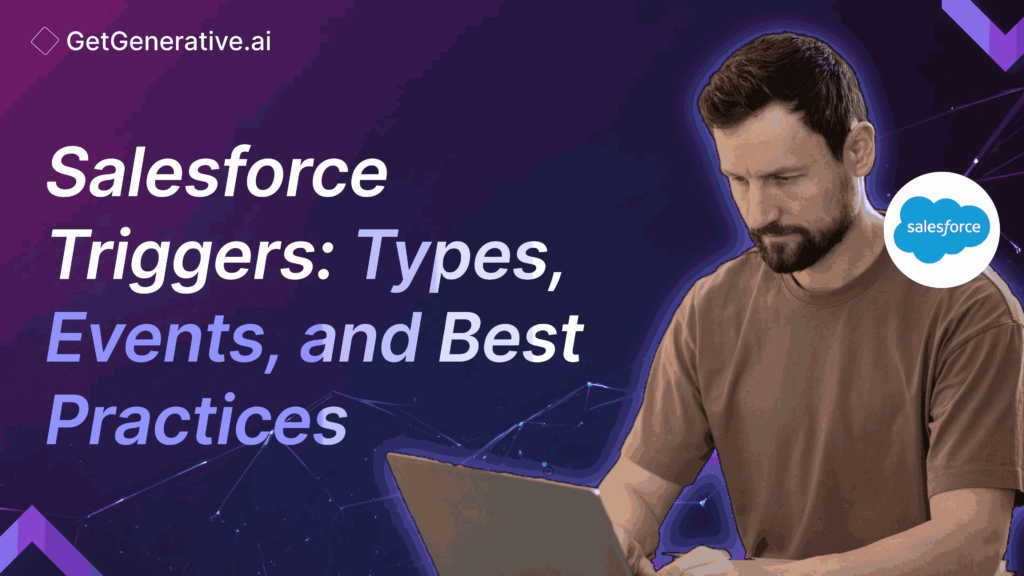Salesforce Triggers: Types, Events, and Best Practices
Salesforce has emerged as a dominant force, with over 150,000 companies worldwide relying on its platform to streamline their business processes. At the heart of Salesforce’s powerful automation capabilities lie Apex triggers – a crucial tool for developers and administrators alike.
As businesses increasingly seek to automate their workflows and enhance data integrity, understanding, and mastering Salesforce triggers have become more important.
What are Salesforce Triggers?
Salesforce triggers are Apex codes that automatically respond to specific data manipulation language (DML) operations or database events. These triggers act as powerful guardians and facilitators of your Salesforce data, ensuring that business logic is consistently applied across your organization’s processes.
Triggers in Salesforce serve multiple purposes:
- Maintaining data integrity and consistency
- Automating complex business processes
- Enforcing business rules and validations
- Updating related records based on changes in other objects
- Integration with external systems
By leveraging triggers, organizations can create sophisticated, automated workflows that respond in real-time to changes in their Salesforce environment, ultimately improving efficiency and data accuracy.
Types of Apex Triggers
In Salesforce, there are two main types of Apex triggers:
- Before Triggers: These triggers fire before a record is inserted, updated, or deleted in the database. Before triggers are ideal for:
- Modifying the record before it’s saved
- Validating data and preventing invalid changes
- Updating fields on the current record
- After Triggers: These triggers fire after a record has been inserted, updated, or deleted in the database. After triggers are useful for:
- Updating related records
- Creating or modifying other records based on the changes
- Sending notifications or emails
- Integrating with external systems
Understanding the differences between these trigger types is crucial for determining when and how to implement them in your Salesforce org.
Trigger Events
Salesforce triggers can be fired on various events, each corresponding to a specific database operation. The main trigger events are:
- Before Insert: Fires before a new record is inserted into the database
- After Insert: Fires after a new record has been inserted into the database
- Before Update: Fires before an existing record is updated in the database
- After Update: Fires after an existing record has been updated in the database
- Before Delete: Fires before a record is deleted from the database
- After Delete: Fires after a record has been deleted from the database
- After Undelete: Fires after a record has been restored from the Recycle Bin
Each event allows developers to intervene at different stages of a record’s lifecycle, allowing for precise control over data manipulation and process automation.
How do I create a before trigger in Salesforce?
Creating a before trigger in Salesforce involves several steps. Here’s a basic example of how to create a before-insert trigger:
- Navigate to Setup in your Salesforce org
- In the Quick Find box, search for “Apex Triggers.”
- Select the object you want to create the trigger for
- Click “New” to create a new trigger
- In the Apex Trigger editor, enter your trigger code
Here’s a simple example of a before-insert trigger that capitalizes the name of an Account before it’s inserted:
trigger AccountNameCapitalize on Account (before insert) {
for(Account acc : Trigger.new) {
if(acc.Name != null) {
acc.Name = acc.Name.toUpperCase();
}
}
This trigger will run before any new Account record is inserted, capitalizing the Account Name field.
Also Read – Governor Limits in Salesforce
What are the best practices for writing Apex triggers?
When writing Apex triggers, following best practices is crucial for maintaining code quality, performance, and scalability. Here are some key best practices:
- Bulkify your triggers: Always write your triggers to handle bulk operations. This means using collections and avoiding SOQL queries or DML operations inside loops.
- One trigger per object: Implement a single trigger per object that handles all events (before insert, after update, etc.). This approach, known as the “trigger framework,” makes managing and maintaining your triggers easier.
- Keep triggers logic-free: Move complex logic into separate Apex classes. This improves code readability and makes it easier to test your trigger logic.
- Use helper classes: Create helper classes to handle the actual logic of your triggers. This promotes code reuse and makes your triggers more modular.
- Avoid hardcoding IDs: Instead of hardcoding IDs or other potentially changing values, store configuration data using custom settings or custom metadata types.
- Handle recursion: Implement mechanisms to prevent trigger recursion, which can occur when a trigger causes itself to fire again.
- Use selective SOQL queries: When querying related records, use selective queries to improve performance and avoid hitting governor limits.
- Implement error handling: Use try-catch blocks to handle exceptions and provide meaningful error messages.
- Write test classes: Always create comprehensive test classes for your triggers to ensure they work as expected and to maintain code coverage requirements.
- Consider order of execution: To avoid unexpected behavior, be aware of the order of execution in which triggers and other automation tools (like flows and processes) execute.
You can create more efficient, maintainable, and scalable Salesforce triggers by adhering to these best practices.
Can triggers be used to update related records?
Yes, triggers can be used to update related records, and this is one of their most powerful features. However, it’s important to note that this is typically done after rather than before triggers.
How do after triggers differ from before triggers?
After triggers and before triggers serve different purposes and have some key differences:
- Timing: Before triggers fire before the record is saved to the database, while after triggers fire after the record has been saved.
- Access to record ID: Before inserting triggers, the new record doesn’t have an ID because it hasn’t been saved to the database. After inserting triggers, you can access the new record’s ID.
- Modifying the current record: Before triggers can modify the current record’s fields (Trigger.new), while after triggers cannot directly modify the current record.
- Database operations: After triggers are typically used for operations that involve other records or external systems, as the current transaction has already been committed.
- Validation: Before triggers are often used for record validation, as they can prevent invalid records from being saved to the database.
- Related record updates: After triggers are generally used for updating associated records, as they can access the current record’s final saved state.
- Roll-up summaries: After triggers are used for custom roll-up summary calculations, as they need the final values of the current record.
Understanding these differences is crucial for determining whether to use a before or after trigger for a specific use case.
Also Read – Wrapper Class in Salesforce
What are the common pitfalls when using Apex triggers?
While Apex triggers are powerful tools, there are several common pitfalls that developers should be aware of:
- Trigger recursion: When a trigger causes itself to fire again, leading to infinite loops or hitting governor limits.
- Lack of bulkification: Writing triggers needing to handle bulk operations efficiently leads to performance issues and governor limit exceptions.
- Hardcoding IDs: Using hardcoded IDs in triggers, which can break when moving between environments or when data changes.
- Overuse of triggers: Implementing too much logic in triggers when other declarative tools (like Process Builder or Flow) might be more appropriate.
- Ignoring the order of execution: Not considering the order in which triggers and other automation tools execute leads to unexpected results.
- Poor error handling: Failing to implement proper error handling makes diagnosing and fixing issues difficult.
- Lack of test coverage: Not writing comprehensive test classes, leading to potential bugs and failing deployments.
- Querying inside loops: Performing SOQL queries inside loops, which can quickly hit governor limits.
- DML operations inside loops: Performing DML operations (insert, update, delete) inside loops, which is inefficient and can hit governor limits.
- Mixing concerns: Putting too much diverse functionality into a single trigger, making it easier to maintain and understand.
Developers can create more robust and efficient Salesforce triggers by knowing these pitfalls and following best practices.
Also Read – Salesforce CRM Implementation With AI – The Ultimate Guide
Conclusion
Salesforce triggers are a fundamental tool in the Salesforce developer’s toolkit. They offer powerful capabilities for automating business processes, maintaining data integrity, and creating sophisticated workflows. By understanding the different types of triggers, their events, and best practices for implementation, developers can harness the full potential of this feature to create more efficient and effective Salesforce solutions.
Enhance your Salesforce consulting with GetGenerative.ai. Effortlessly craft outstanding proposals, enabling you to dedicate more time to providing exceptional client service.
Start today!
FAQs
1. Can I have multiple triggers on the same object?
Yes, but a single trigger per object is recommended for better manageability.
2. How many times can a trigger fire in a single transaction?
A trigger can fire 200 times in a single transaction.
3. Can triggers call external web services?
Yes, but this should be done after triggers and with caution due to governor limits.
4. Are there governor limits specific to triggers?
Yes, triggers are subject to the same governor limits as other Apex codes.
5. Can I temporarily disable a trigger?
You can create an on/off switch for triggers using custom settings or metadata.




